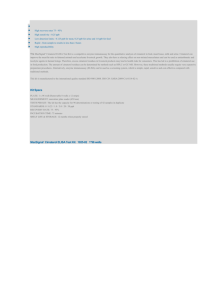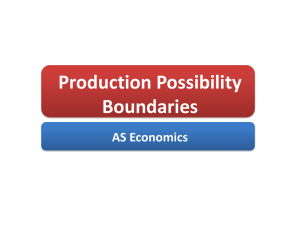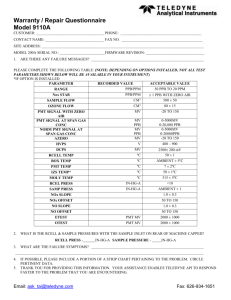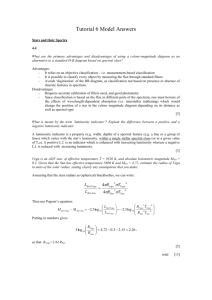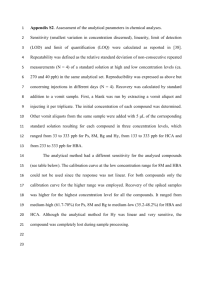EM_5_01 - Indico
advertisement
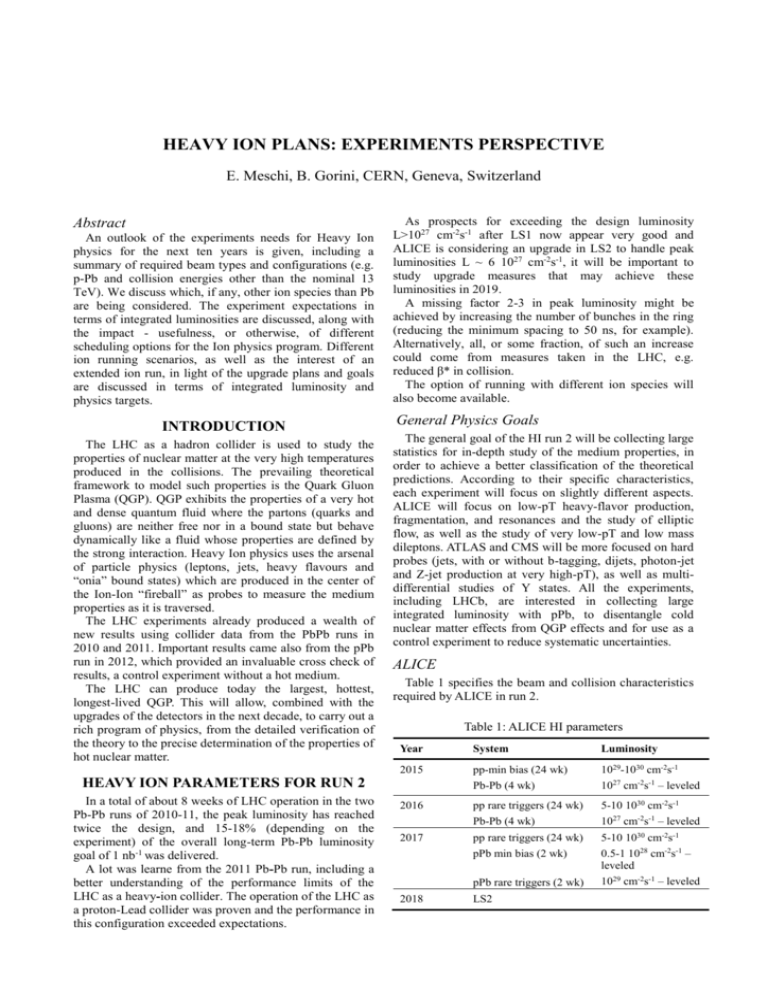
HEAVY ION PLANS: EXPERIMENTS PERSPECTIVE E. Meschi, B. Gorini, CERN, Geneva, Switzerland Abstract An outlook of the experiments needs for Heavy Ion physics for the next ten years is given, including a summary of required beam types and configurations (e.g. p-Pb and collision energies other than the nominal 13 TeV). We discuss which, if any, other ion species than Pb are being considered. The experiment expectations in terms of integrated luminosities are discussed, along with the impact - usefulness, or otherwise, of different scheduling options for the Ion physics program. Different ion running scenarios, as well as the interest of an extended ion run, in light of the upgrade plans and goals are discussed in terms of integrated luminosity and physics targets. INTRODUCTION The LHC as a hadron collider is used to study the properties of nuclear matter at the very high temperatures produced in the collisions. The prevailing theoretical framework to model such properties is the Quark Gluon Plasma (QGP). QGP exhibits the properties of a very hot and dense quantum fluid where the partons (quarks and gluons) are neither free nor in a bound state but behave dynamically like a fluid whose properties are defined by the strong interaction. Heavy Ion physics uses the arsenal of particle physics (leptons, jets, heavy flavours and “onia” bound states) which are produced in the center of the Ion-Ion “fireball” as probes to measure the medium properties as it is traversed. The LHC experiments already produced a wealth of new results using collider data from the PbPb runs in 2010 and 2011. Important results came also from the pPb run in 2012, which provided an invaluable cross check of results, a control experiment without a hot medium. The LHC can produce today the largest, hottest, longest-lived QGP. This will allow, combined with the upgrades of the detectors in the next decade, to carry out a rich program of physics, from the detailed verification of the theory to the precise determination of the properties of hot nuclear matter. HEAVY ION PARAMETERS FOR RUN 2 In a total of about 8 weeks of LHC operation in the two Pb-Pb runs of 2010-11, the peak luminosity has reached twice the design, and 15-18% (depending on the experiment) of the overall long-term Pb-Pb luminosity goal of 1 nb-1 was delivered. A lot was learne from the 2011 Pb-Pb run, including a better understanding of the performance limits of the LHC as a heavy-ion collider. The operation of the LHC as a proton-Lead collider was proven and the performance in this configuration exceeded expectations. As prospects for exceeding the design luminosity L>1027 cm-2s-1 after LS1 now appear very good and ALICE is considering an upgrade in LS2 to handle peak luminosities L ~ 6 1027 cm-2s-1, it will be important to study upgrade measures that may achieve these luminosities in 2019. A missing factor 2-3 in peak luminosity might be achieved by increasing the number of bunches in the ring (reducing the minimum spacing to 50 ns, for example). Alternatively, all, or some fraction, of such an increase could come from measures taken in the LHC, e.g. reduced β* in collision. The option of running with different ion species will also become available. General Physics Goals The general goal of the HI run 2 will be collecting large statistics for in-depth study of the medium properties, in order to achieve a better classification of the theoretical predictions. According to their specific characteristics, each experiment will focus on slightly different aspects. ALICE will focus on low-pT heavy-flavor production, fragmentation, and resonances and the study of elliptic flow, as well as the study of very low-pT and low mass dileptons. ATLAS and CMS will be more focused on hard probes (jets, with or without b-tagging, dijets, photon-jet and Z-jet production at very high-pT), as well as multidifferential studies of Y states. All the experiments, including LHCb, are interested in collecting large integrated luminosity with pPb, to disentangle cold nuclear matter effects from QGP effects and for use as a control experiment to reduce systematic uncertainties. ALICE Table 1 specifies the beam and collision characteristics required by ALICE in run 2. Table 1: ALICE HI parameters Year System Luminosity 2015 pp-min bias (24 wk) Pb-Pb (4 wk) 1029-1030 cm-2s-1 1027 cm-2s-1 – leveled 2016 pp rare triggers (24 wk) Pb-Pb (4 wk) 5-10 1030 cm-2s-1 1027 cm-2s-1 – leveled 2017 pp rare triggers (24 wk) pPb min bias (2 wk) 5-10 1030 cm-2s-1 0.5-1 1028 cm-2s-1 – leveled 1029 cm-2s-1 – leveled pPb rare triggers (2 wk) 2018 LS2 To be noticed in particular is the need for a 4-5 orders of magnitude luminosity reduction in IP2. No filling scheme tricks will be available at 25ns bunch-spacing, and basically all bunches will collide in ALICE (except for the effect of the abort gap). A larger β* is not a viable option due to aperture issues in IP2, hence, a separation of order 5σ will be needed. Whether the level of background in IP2 will be lower than the expected signal remains an open question, and will largely depend on the quality of the vacuum achieved after the LS1 intervention. ALICE studied the beam-gas background conditions in LSS2-L assuming a 5 10-9 vacuum. The result is a rather strong MB trigger contamination (~50%) at L=1 10 29. On the other hand the contamination at L=1 1030 is ~10%, at the price of a higher pileup of order 10 in the TPC. Further studies of optimization will be performed based on these results. ATLAS and CMS Both ATLAS and CMS assume a HI run at the end of each year as in the baseline LHC schedule. A leap of one year, although not desirable, could be acceptable to ATLAS if helping with overall efficiency. For both experiments, the ultimate goal is to collect 2-3 nb-1 before LS3. For 2015-2016, the two collaborations request PbPb at 5 TeV c.m. energy, and a corresponding amount of intermediate energy reference pp data. CMS would consider having the second high luminosity PbPb run at the same energy as the first one (i.e. 5 instead of 5.5), depending on the impact on setup time and achievable instantaneous luminosity – as this would require a single set of reference pp data, which will also be useful for pPb. For 2017 both collaborations request pPb at high luminosity. Running pPb at the same c.m. energy as PbPb instead of the top energy (8.2) is an option for CMS as it would allow to minimize the number of pp reference data sets needed. More studies are needed to balance the gain in high pT statistics vs availability of reference data. ATLAS definitely favors one pPb run at 8.2 TeV before LS3. Concerning reference pp data at intermediate energy, a data set equivalent to the Pb+Pb data set (a pp integrated luminosity of ~3-4104 the Pb-Pb one) is considered absolutely necessary and needs to be kept in sync with Pb+Pb ∫Ldt “steps”. Therefore, it is not possible to concentrate all reference pp data taking in a single period during 2015-2022. LHCb Due to the huge track multiplicity in Pb-Pb collisions in the forward direction (2 < η < 5), the LHCb collaboration plans to participate only in a pPb run, as in 2013, and considers preferable to have p-Pb run not at the end of the HI program of run 2. The goal is to collect at least 10 times the integrated luminosity of 2013, when the experiment operated at ~5x1027/cm2/s. Assuming another p-Pb run would last also about 4 weeks, a luminosity greater than 5x1028/cm2/s should be provided to LHCb. The compatibility of this luminosity with machine limitations in the pPb scheme needs to be verified. Experience has shown that a pp data sample at the corresponding pPb energies, i.e. at 5 TeV and/or 8.2 TeV. is important for LHCb Conclusions All experiments agree that HI run periods should not be grouped, and that the general goal is to collect as much integrated luminosity as possible for PbPb and pPb, with the general goal of collecting at least 1 nb-1 with one HI run period per year between 2015 and LS2. Concerning the beam energy, one clear advantage in choosing a single value of √sNN is the pp reference sample just keeps adding up, and all experiments seem to consider running PbPb again at 5 TeV acceptable. Physics considerations must be weighed against the obvious advantages for reference pp samples in considering keeping the same (lower) energy also for the next pPb run. Since ALICE requires leveling during PbPb and pPb running before LS2, ATLAS and CMS might need to be also leveled to guarantee constant luminosity to ALICE in the presence of large burn-off. Delivering the same luminosity to all IPs, although slightly penalizing for IP1/5, would be the easiest option. The request of LHCb for a factor 10 more luminosity in IP8 requires squeezing of the 4 IPs, and at the time of writing it is not clear how technically difficult this is. The generally agreed schedule would then look like this: 2015: PbPb at 5.02 TeV 2016: PbPb at 5.02 (5.5) TeV 2017: pPb at 5.02 (8.2) TeV Concerning the use of ion species other than lead before LS2, only ATLAS expresses a slight preference for a possible ArAr run. In any case no request is made for different species during the same year. BEYOND LS2 The general expectation of the HI community is to collect 2-3 nb-1 before LS3, with an ultimate goal and a physics case for collecting ≥ 10 nb-1 by the end of the LHC program. Upgrades ALICE will install its major detector upgrade during LS2 in 2018. The upgrade aims at precision measurements of the Quark Gluon Plasma, with a factor 100 gain in statistics (x10 luminosity, x10 via pipelined readout), with the aim of a Pb-Pb recorded luminosity ≥ 10 nb-1, or 8 x 1010 events (Run2+3). The upgrade will also allow an increased pp capability, aiming at a recorded luminosity ≥ 6 pb-1, or 1.4 x 1011 events. A new, ultra-low mass silicon tracker will be installed around a very small beam-pipe (ID 34.4 mm). The upgrade of the TPC with GEM detectors will allow continuous (ungated) readout, while the electronics upgrade of the other sub-detectors will permit the read out of all Pb-Pb interactions at a maximum rate of 50kHz (i.e. L = 6x1027 cm-1s-1) with a minimum bias trigger. Processing such rates will require a major upgrade of the online systems, with data reduction based on reconstruction of clusters and tracks. ATLAS will add a pixel layer during LS1, then an entirely new tracker will be installed in LS3: this will dramatically improve the tracking and b-tag capabilities. A fast tracking trigger will be installed in LS2 to aid highmultiplicity tracking. Calorimeter and muon upgrades in LS2 will improve the electron, γ identification, as well as improve the muon triggers efficiency in the presence of large pileup. The upgraded TDAQ system will allow higher L1 rates and larger data volumes. CMS L1 trigger upgrade, implemented during LS1, will enable the experiment to tolerate an interaction rate of up to ~50kHz for PbPb. Then the complete upgrade of trigger and DAQ in LS2 will include an HI-specific development to reach the necessary L1 rejection at 95%, from 50 kHz to <3 kHz (HLT). The new pixel tracker, installed before LS2, then new tracker in LS3, will preserve and improve the tracking and b-tagging capabilities of the experiment in the presence of large pileup. In LS2 the forward muon system will be extended to improve muon acceptance. The LHCb detector upgrade, including new vertexing and tracking detectors, will also take place in LS2. Although not specifically focused on HI physics, it will clearly benefit it. The HI (pA) physics community in LHCb is still small, but might build up during Run2. Heavy Ion Operations After LS2 The main interventions on the accelerator related to HI physics will concern the upgrade of the SPS injection system, and the installation of collimators in the dispersion suppression region around IR2 (possibly also in IR7) for ions. The ATLAS and CMS collaborations remark that in case the magnet quench limits should be reached in IP1/5, the installation of dispersion suppression collimators as in IP2 would be desirable. To increase instantaneous luminosity, all experiments support going to a 100 ns bunch spacing as early as possible, as long as the development of the SPS injection kickers does not distract from pp upgrades. In view of this, the LHC vacuum in the LSS around IP2 needs to be improved by an order of magnitude to mitigate background. HI operation after LS2 will still focus on PbPb a pPb. However, running with lighter species, namely ArAr and pAr, is considered important, in particular to better study jet quenching, since the lower underlying event multiplicity reduces the systematic error on the measurements. It is also deemed that running with ArAr collisions will potentially deliver a higher Ncoll- weighted luminosity. The LHCf collaboration has expressed interest in collisions with Nitrogen ions, which would be the best for modeling of cosmic-ray interaction in the atmosphere, while using Oxygen would also be acceptable. Run 3 Scenarios As anticipated, the general goal of the Run 3 is to collect at least 3 nb-1 of integrated luminosity. The basic assumption for scheduling is to continue the pattern of one month of HI operation of the LHC per year. Besides ATLAS and CMS, ALICE will require the collection of reference pp data at intermediate energy (5.5 TeV). Although D and B cross sections can be scaled in √s with pQCD, large scaling uncertainties result for charm at low pT (>50%). Furthermore, there is no robust theoretical guidance for interpolating quarkonia production rates, and jet energy scale calibration depends strongly on √s. For all these reasons, ALICE will require approximately 10 pb-1of pp reference data to achieve a statistical error negligible wrt Pb-Pb (e.g. 1/√2). This can be achieved e.g. by running for 106 s at 200 kHz (with L leveled at 6x1030). ATLAS and CMS need to match the PbPb yields at high pT for 10 nb-1 of PbPb collisions which will require an ultimate reference pp sample of 300 pb-1. The priority of operating with ArAr and pAr after LS2 will be defined based on the outcome of analysis of high statistics PbPb and pPb from Run 2. A possible scenario for Run 3 HI operation could therefore be the following: 2019 – PbPb 2 nb-1 (and/or ArAr as per ATLAS request…?) + pp 60 pb-1 (ATLAS/CMS), 3 days (ALICE) ... 2020 – PbPb 2 nb-1+ pp 60 pb-1 (ATLAS/CMS), 3 days (ALICE) … 2021 – pPb/pAr? (1/2 each) + complete pp reference run 2022/2023 LS3 AFTER LS3 The HI groups in the collaborations, and in particular the ALICE collaboration, are working on a physics case for running the upgraded LHC with heavy ions (HL-HILHC). The general goal would be to collect more than 10 nb-1 in a single run, thus allowing the study of QGP properties with unprecedented precision. REFERENCES [1]
